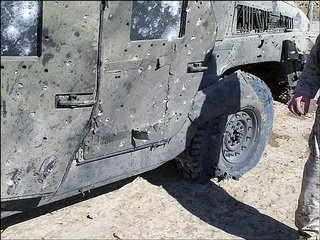 War Costs Approach $10 Billion a Month
War Costs Approach $10 Billion a Month
by Jonathan Weisman for the San Francisco Chronicle
April 20, 2006
Annual war expenditures in Iraq will almost certainly come close to doubling since the U.S. invasion, as the military confronts the rapidly escalating cost of repairing, rebuilding and replacing equipment chewed up by three years of combat. The cost of the war in U.S. fatalities has declined this year, but the cost in treasure continues to rise -- from $48 billion in 2003 to $59 billion in 2004 to $81 billion in 2005 to an anticipated $94 billion in 2006, according to the Center for Strategic and Budgetary Assessments. The U.S. government is now spending nearly $10 billion a month in Iraq and Afghanistan, up from $8.2 billion a year ago, a new Congressional Research Service report found. Annual war costs in Iraq are easily outpacing the $61 billion a year that the United States spent in Vietnam between 1964 and 1972, in today's dollars. The Iraq invasion's "shock and awe" phase of high-tech laser-guided bombs, cruise missiles and stealth aircraft has long faded, but the costs of even those early months are just coming into view as the military confronts equipment repair and rebuilding costs it has avoided and procurement costs it never expected.
"We did not predict early on that we would have the number of electronic jammers that we've got. We did not predict we'd have as many (heavily) armored vehicles that we have, nor did we have a good prediction about what our battle losses would be," Army Chief of Staff Gen. Peter Schoomaker recently told the Senate Armed Services Committee. "If you look at the earlier estimates of anticipated costs, this war is a lot more expensive than it should be based on past conflicts," said Steven Kosiak, director of budget studies for the Center for Strategic and Budgetary Assessments, an independent defense think tank.
The issue will be hotly debated next week when the Senate takes up a record $106.5 billion emergency spending bill that includes $72.4 billion for the wars in Iraq and Afghanistan. The House passed a $92 billion version of the bill last month that included $68 billion in war funding. That comes on top of $50 billion already allocated for the war this fiscal year. The bill is the fifth emergency defense request since the Iraq invasion in March 2003. Senate Democrats say that, in the end, they will vote for the measure, which congressional leaders plan to deliver to President Bush by Memorial Day. But the upcoming debate will offer opponents of the war ample opportunity to question the Bush administration's funding priorities. At roughly $15 billion, personnel costs will actually drop 14 percent this year. But Pentagon officials and budget analysts point to a simple, unavoidable driver of the escalating costs -- the cost of repairing and replacing equipment and developing new war-fighting materiel has exploded. In the first year of the invasion, such costs totaled $2.4 billion, then rose to $5.2 billion in 2004. This year, they will hit $26 billion, and could go as high as $30 billion, Kosiak said.
Total operations and maintenance budgets will rise 33 percent this year, while investment in new technologies will climb 25 percent, according to the Congressional Research Service. The helicopters, tanks, personnel carriers and even small arms "have required more maintenance than we planned for," said Gary Motsek, director of support operations at the Army Materiel Command. "We're working them to death." In the first years of the war, Army and Marine units rotating out of Iraq left behind usable equipment for the next units rolling in. But even the working equipment is now being shipped back to the Army's five depots, where they are refurbished and upgraded.
Last year, the depots repaired and upgraded 600 helicopter engines. This year, they will see 700, Motsek said. A total of 318 Bradley fighting vehicles went through the depots in 2005; 600 will be cycled through in 2006. Last year, depot workers upgraded 5,000 humvees with new engines and new transmissions to support ever-heavier armor. This year, they will see close to 9,000. They also will have to patch up 7,000 more machine guns, 5,000 more tank tracks and 100 more M1A1 Abrams tanks. In 2001, the depots logged 11 million labor hours. Last year, that reached 20 million, and this year, it will total 24 million, Motsek said. And that is only the work being done in the United States. In and around Iraq, 53,000 people -- 52,000 of them contractors -- are maintaining and rebuilding lightly damaged equipment, a senior Senate defense aide said. Indian workers are refurbishing U.S. humvees for $6 an hour. "The equipment is wearing out five times faster than (in) normal operations," said Jeremiah Gertler, a senior fellow at the Center for Strategic and International Studies and a former House Armed Services Committee staffer. What cannot be repaired has to be replaced. Procurement costs were a fraction of the initial emergency war requests, Kosiak said. This year, new equipment purchases will consume 20 percent of the war funds. Such costs were always there, Gertler said, but Bush administration officials and members of Congress put off maintenance and procurement expenditures to keep the war price tag down.

No comments:
Post a Comment